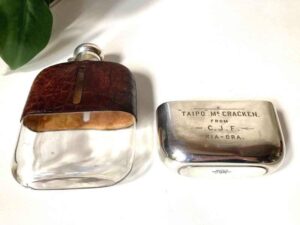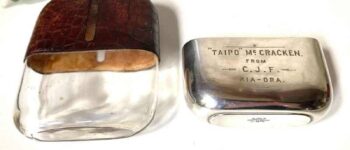1902: Taipo Explosives Ltd.
December 14, 2024
By AHNZ
 A new article in the Otago Daily Times reveals a bit of Dunedin history by John Lewis. Mostly the information is directly cribbed from from this Gumtree listing (aka “Australian online antique auction site” but really just Aussie Trade Me.) It concerns a fairly common old drinking flask but with engravings relevant to our history.
A new article in the Otago Daily Times reveals a bit of Dunedin history by John Lewis. Mostly the information is directly cribbed from from this Gumtree listing (aka “Australian online antique auction site” but really just Aussie Trade Me.) It concerns a fairly common old drinking flask but with engravings relevant to our history.
“‘Taipo’ McCracken was an explosives inventor from Dunedin…Mr McCracken’s first explosive was called Mortite, and his second Satanite.” – HeatherR, Gumtree
The advertising material for Satanite is excellent and highly irreligious! See below. But it dates from 1908 after the ‘Taipo’ explosive compound had been discredited.
During the exciting and militant times of the Boer War it seemed like a great idea to have an explosives factory at Deborah Bay (Dunedin.) Useful for mining (and for killing Boers?) it got going in 1902 in the same year the war wrapped up. It burned down in 1904 and never bounced back. In particular, Taipo Explosives Co. Ltd. failed field tests in South African mines and that led to the company there going into liquidation in July 1905
However, Adam ‘Taipo’ McCracken kept shopping his explosives around right up to 1910. He got around. The newspapers place him or his business in Los Angeles, London, Dunedin, Christchurch, Melbourne, and Johannesburg.
“Mr Adam McCracken, of Christchurch, the inventor of two new explosives of high power, known respectively as Mortite and Satanite, is negotiating in London on behalf of influential syndicates in Melbourne and New Zealand for the sale of ( these inventions to the British Government for naval and military purposes.” – Pelorus Guardian and Miners’ Advocate. (1910,) Papers Past
“The Inspector for Mines for the Southern Mining District (says the New Zealand “ Mines Record ’’) states that the explosive “ Taipo,” which is now being manufactured at Port Chalmers, is likely to prove a beneficial factor in quartz and other mines, as not only is the explosive powerful in action, but the resultant fumes are practically harmless to the health of the workmen. This is confirmed by trials made at Johannesburg, where exhaustive tests are reported to have been made of the smoke taken from a blast by the chemist of the Eckstein mines, who reported that it was innocuous and antiseptic. Two trials made at the City and Suburban Mine, Johannesburg, showed that it was considerably stronger than blasting- gelatine.” – Coolgardie Miner (1904,) Trove
Taipo, n. Goblin. – A Dictionary of the Maori Language, Herbert Williams (1957)
“The second annual! general meeting of the members of the Tuiuo Explosive Syndicate wns held on tho 30th ult., Mr G. L. Penniston occupying tho chair.” – ODT (1904,) Papers Past
““Taipo” explosive powder was a Kiwi invention, heralded as the next big thing in mining explosives – safe, stable, and free from toxic fumes. The Taipo Explosives Syndicate Limited was formed in 1902, and similar syndicates and sales of the rights to manufacture the powder appeared as far afield as Australia, the USA, England and South Africa.” – Torpedoes, Explosions, and an Alleged Slave Ship: Deborah Bay’s Astonishing Past, Kiwi Adventures (2018)
 McCraken never quite got his explosive enterprise to stick but he had powerful backers in government. Attending the opening of the Taipo Explosive Works. “A New Industry…Parliament was represented by Mesrs J. A Millar and T. Mackenzie…and Hon W. M. Bolt.” Joe Ward very nearly there as well. Ref. ODT (1904,) Papers Past
McCraken never quite got his explosive enterprise to stick but he had powerful backers in government. Attending the opening of the Taipo Explosive Works. “A New Industry…Parliament was represented by Mesrs J. A Millar and T. Mackenzie…and Hon W. M. Bolt.” Joe Ward very nearly there as well. Ref. ODT (1904,) Papers Past
Mastering the affair was major mover and shaker (and Dunedin’s Mayor 1901-2) George Denniston¹.
Harman Reeves, son of another one-time Dunedin Mayor (1876-7) Charles Reeves also got in on the action. Reeves says in his autobiography that it was the time of the collapse of the dredging boom. Around 1901 he was on the rebound from deciding not to go ahead with minging at Ngahere in the Grey Valley (where there is, in fact, still a dredge in the 2020s) and from the decline of the War (which might also have made him a “fortune.”) “In 1901, when the Boer War was drawing to a conclusion, and our local dredging boom was begin- ning to peter out, I thought I might make a fortune by going to South Africa; so I got in touch with Sir Joseph Ward..” Ref. In the years that are gone, Harman Reeves (1947,) Papers Past
Reeves found himself with a lot of other high-flyers invested in Taipo Explosives Co. Ltd. He took that back to South Africa and formed Taipo Explosives Co. (South Africa) Ltd with a view to blowing rare minerals out of the rocks there. Big successful explosion tests make the share price go up. But, then, follow-up tests were an unfortunate failure. “Instead of the explosive blowing the rock all round as it did in Pietermaritzburg, it simply shot out, as out of the mouth of a cannon, and did not shatter the country around or loosen the rock. Two or three shots were made like this, which was a great disappointment, as can be imagined. The Company manufactured further lots of explosive, but somehow the new explosive was not a success, and the Company eventually went into liquidation.” Ref. ibid
McCracken’s explosives plant caught fire on 2 September 1904 only 4 months after opening. Two men were “seriously burned.” According to a commenter to Kiwi Adventures his Grandfather Robert Johnston was killed in the blaze. “They even tried to put a positive spin on the event by declaring that this proved beyond a doubt that Taipo was fire-safe – for with the quantity of explosive that burned away in the fire, if it hadn’t have been I’d be writing about Deborah Crater right now.” Ref. Kiwi Adventures (2018)
On New Year’s Day 1906 a young man, Alfred Lewis, knew where he could get something to go BOOM! Picking over the ruins of the derelict old Deborah Bay site the amatuer pyrotechnician picked up some of the leftovers to celebrate with and blew himself away! Ref. Newcastle Morning Herald and Miners’ Advocate (1906,) Trove
Adam McCracken may have been a success but we’ll never know as his endeavours were polluted by government backing. The political people believed in his potential to be the Kiwi Alfred Nobel so it must have been hard to put the breaks on. Maybe he needed to walk when they wanted him to run? Even the media referred to Adam as Taipo McCracken. The flask probably dates from his zenith in mid-1904 when things were going well for Adam. Perhaps someone in the company wishing Taipo (who wasn’t present at the plant opening) on one of his offshore trade missions? Like his son, Adam Jr, it wound up in Australia.
To really solve the mystery it would help to figure out who gave McCracken the flask: CJF.
The bidding on Gumtree for the flask is at $350.00.
 Like Comment Share
Like Comment Share





